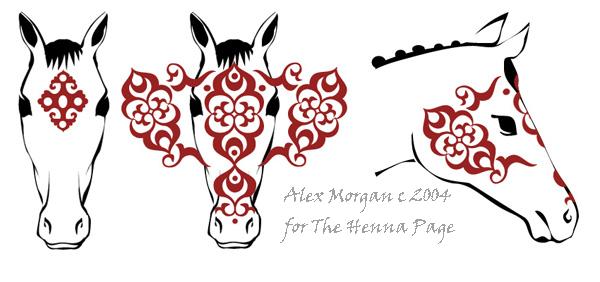at Springtime
Festivals in Lebanon
Catherine Cartwright-Jones
c 2004
Henna and HorsesCatherine Cartwright-Jones
c 2004

| There were a series of springtime festivals
celebrated in Lebanon that were set outside the Muslim Lunar calendar,
so the festivals always fell in the spring. These were celebrated
on the successive Thursdays of the six weeks that preceded Eastern
Orthodox Easter Sunday. These festivals were celebrated by all
the peasants generally, Muslim, Jewish and Christian. On two of
these festivals, horses and other domestic animals got henna! The first of the Thursday festivals, "Thursday-of-the-Animals", all animals were said to meet and mate, to reproduce their kind. Domestic animals didn't have to work on that Thursday, and got to enjoy themselves. Owners applied henna to their favorite work animals' and pets' foreheads, as a sign of blessing and life. On the last Thursday before Orthodox Easter, villagers from about 30k surrounding went to the domed shrine of Wali Zaur. The festival was often attended by around 2000 people. Villagers dressed up in their best clothes and came in by car, donkey, horse, horse and cart, and bicycle, until the festival area was crowded. Riders adorned their donkeys and horses with blue beads and colored garlands, and dyed their horses tails with henna. Arabian horses tend to carry their tails high, so the prized white Arabian horse's hennaed tails looked like brilliant red-orange plumes. Bicycle riders decked their bicycles with paper flowers and ribbons. The crowd went to the Wali Zaur shrine for blessing, and women who wanted to become pregnant went to a well near the shrine for fertility, health and well-being. In the evening, when people returned to their villages, the celebration continued. People danced in lines, men and women danced shoulder to shoulder for the celebration of spring! This springtime festival was celebrated in variants through the Beqaa valley, from Syria into Lebanon, into former Palestine, and may be related to springtime festivals celebrated with henna dating back to 2000 BCE in the same region. Reference: Buarij: Portrait of a Lebanese Muslim Village Anne Fuller , Cambridge, Mass Center for Middle Eastern Studies of Harvard University 1961, pp 84-6 Alex Morgan's Horse Pattern adapted from: Chamfron and Cheek Pieces for a Parade Horse, Ottoman Turkey, or Egypt, 18th c. More patterns for horses from Alex Morgan are in her her book, "Warrior" Back to The Encyclopedia of Henna Index Can't find what you're looking for? Try: The Henna Page Main Index http://www.hennapage.com/henna/mainindex.html *"Henna,
the
Joyous Body Art"
the Encyclopedia of Henna Catherine Cartwright-Jones c 2000 registered with the US Library of Congress TXu 952-968 |